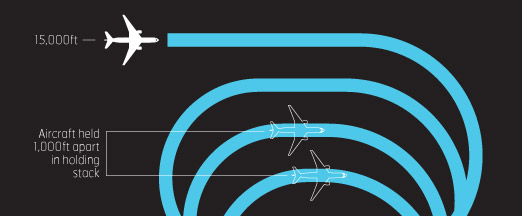Most, if not all of us who have flown into London Heathrow will have experienced their aircraft being ‘held’ – circling on the outskirts of the airport – before being given clearance to land.
But interestingly, from an operational point of view the reality is that holding is not actually a symptom of inefficiency.
In fact, Heathrow Airport schedules holding into the system. This might sound crazy but holding is actually a very efficient way of ensuring an airport with constrained runway capacity, like Heathrow, makes maximum use of the landing slots it has available.
There are four holding points around Heathrow, all of which help our controllers to properly order arriving aircraft to make best use of all those available slots. This is a balancing act that requires an enormous amount of skill.
Types of aircraft
Much depends on the type of aircraft that are waiting to land. A very big aircraft, for example an Airbus A380, creates a lot of turbulence in its wake, so if the aircraft following is something smaller like a Boeing 737, the controller has to provide a larger separation distance between them – which obviously then takes up more time and distance in the approach sequence.
However, the larger the aircraft that is following, the lower affect this turbulence will have on that aircraft and therefore the aircraft can safely follow at a closer distance.
Runway capacity
Another benefit of operating a hold is that it allows the controller to bring them into land in the order that makes very most of the available runway capacity. Getting the order wrong costs time and money and with Heathrow at 98% capacity, a miscalculation can send ripples of delay through the rest of the schedule. That’s why NATS controllers are trained to the highest standards and it takes up to three years to ‘go solo’ as a Heathrow approach controller.
All this is not to say that holding is ideal. Holding aircraft burn more fuel and release more CO2 in to the atmosphere, but when ground infrastructure is limited it’s one of solutions available to ATC and the Airport.
With more space and time, it’s possible to slow the aircraft down en-route in order to lessen the need to hold on arrival. In fact, there is an operational trial at Heathrow currently underway to see how this could be developed further.
Infographic
We’ve created an infographic, shared below, to help explain holding and how if managed correctly, it can influence efficiency at an airport.
So next time you’re put into holding, please don’t think it’s just because we can’t keep up, it’s actually part of a carefully managed process to optimise efficiency at very busy airports!
Click the infographic to enlarge it.
Comments
Please respect our commenting policy and guidelines when posting on this website.


14.01.2015
23:23
Andrew Selwood
Great work Paul! A very through insight to the issue of landing at Heathrow airport!